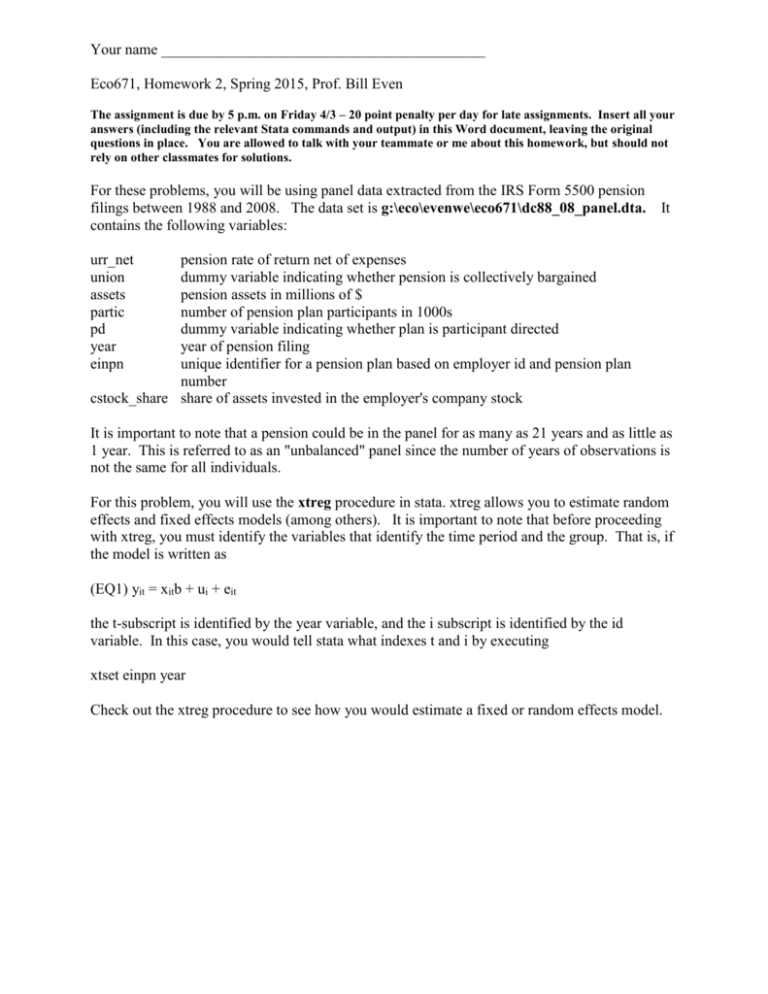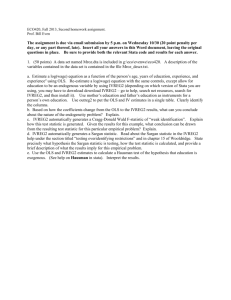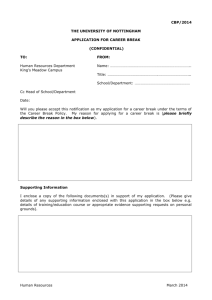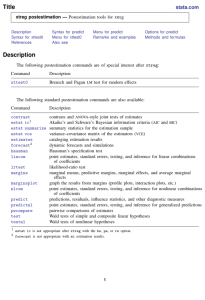Directions: The homework is due by noon on Monday 3/29
advertisement

Your name ___________________________________________
Eco671, Homework 2, Spring 2015, Prof. Bill Even
The assignment is due by 5 p.m. on Friday 4/3 – 20 point penalty per day for late assignments. Insert all your
answers (including the relevant Stata commands and output) in this Word document, leaving the original
questions in place. You are allowed to talk with your teammate or me about this homework, but should not
rely on other classmates for solutions.
For these problems, you will be using panel data extracted from the IRS Form 5500 pension
filings between 1988 and 2008. The data set is g:\eco\evenwe\eco671\dc88_08_panel.dta.
contains the following variables:
It
urr_net
union
assets
partic
pd
year
einpn
pension rate of return net of expenses
dummy variable indicating whether pension is collectively bargained
pension assets in millions of $
number of pension plan participants in 1000s
dummy variable indicating whether plan is participant directed
year of pension filing
unique identifier for a pension plan based on employer id and pension plan
number
cstock_share share of assets invested in the employer's company stock
It is important to note that a pension could be in the panel for as many as 21 years and as little as
1 year. This is referred to as an "unbalanced" panel since the number of years of observations is
not the same for all individuals.
For this problem, you will use the xtreg procedure in stata. xtreg allows you to estimate random
effects and fixed effects models (among others). It is important to note that before proceeding
with xtreg, you must identify the variables that identify the time period and the group. That is, if
the model is written as
(EQ1) yit = xitb + ui + eit
the t-subscript is identified by the year variable, and the i subscript is identified by the id
variable. In this case, you would tell stata what indexes t and i by executing
xtset einpn year
Check out the xtreg procedure to see how you would estimate a fixed or random effects model.
Your name ___________________________________________
Eco671, Homework 2, Spring 2015, Prof. Bill Even
1. (5 points) Estimate a rate of return regression with controls for union, the number of
participants, dollars of assets, participant direction and the share of assets invested in the
company’s stock, and a set of year dummies.1 Estimate the following 4 models
a. ols with standard errors corrected for clustering by einpn (OLS)
b. random effects (RE)
c. fixed effects (FE)
d. random effects after deleting all plans with only one observation2 (RE2)
e. fixed effects after deleting all plans with only one observation (FE2)
Restrict the sample to observations that have no missing data on any of the dependent or
independent variables. Summarize your results in a single table using the outreg2 command.
Use the “ctitle” option to provide column titles in your table and use the specification labels
provided above.
2. (5 points) Discuss the difference in the underlying assumptions about the variance-covariance
matrix for (a) vs (b). Asssuming the underlying assumptions of each are correct, which is more
efficient?
3a. (8 points) In the random effects model, there is a two part error term (ui + eit ). After you
estimate the RE model, use the predict command to generate predicted values of urr_net, and
generate the predicted residuals as the difference between the actual and predicted urr_net. Use
these residuals (which represent ui + eit ) to create estimates of each part separately. Do not use
the Stata predict commands to generate the separate parts. [Hint: for each einpn, the mean of eit
is zero.] After you create the two parts, confirm that you get the same estimate of “rho” (the
within group correlation of residuals) that is provided by the xtreg procedure.
3b. (5 points) Using your estimates of ui and eit. provide estimates of the variance for each
component. Compare your estimates to those provided by xtreg. [Note: summarize command
will provide estimates of variance but will not use the appropriate degrees of freedom. You are
better off creating your own estimate of the sum of squared errors so that you can divide by the
appropriate df.]
4. Over time, there has been a shift in pension plans to “participant direction” where individuals
choose how to allocate their pension contributions across a menu of investment options. This
requires individual accounts and could drive up the expense of the pension and thus reduce the
return. The alternative option is where a single trustee pools all the funds and invests them in a
common portfolio of assets (trustee directed plans).
1
Note: A simple way to add dummy variables for a categorical variable (like year) is to use factor variables. For
example, reg y i.year would regress y on a set of year dummies. Stata will automatically choose which year is the
reference group, but you can control that. For example, reg y ib2008.year would force 2008 to be the “base” or
“reference” year.
2
To compute the number of observations for a plan, you can use the following command:
bysort einpn: egen n=count(einpn)
Your name ___________________________________________
Eco671, Homework 2, Spring 2015, Prof. Bill Even
a. (5 points) Based on the results from your OLS and RE regressions in (1a-b), does it appear
that participant direction increases or decreases the rate of return on pension assets? Explain.
b. (8 points) Compare the estimated effects of participant direction from the FE model with that
from the RE and OLS model. Based on the observed changes, what does this tell you about the
nature of the pension specific heterogeneity (ui)? Be sure to explain why the estimated effects
would move in the observed direction.
5. (8 points) Test whether the assumptions necessary for the random effects model are
appropriate (check out hausman). Explain the difference in the assumptions of the RE and FE
model. If the RE assumptions are inappropriate, why is the FE model preferred? If the RE
assumptions are appropriate, why would the RE model be preferred over the FE model? (You
can find more info on the Hausman test in xtreg at
www.stata.com/info/capabilities/panel/xtreg.html).
6. (8 points) When you dropped the pension plans with only one observation (1d-e), did it
change the RE estimates? The FE estimates? Should the elimination of such observations affect
the RE or FE estimates? Why or why not?
7. (8 points) Re-estimate the FE model by creating “deviations from individual specific
means”.3 Recall that this model should not have an intercept included (see the noconstant
option in reg.)
a. How do the slope coefficients from xtreg with FE and those obtained here compare? Is
this consistent with what you expected? Why or why not?
b. How do the standard errors on the coefficients compare? Is this consistent with what
you expected? Why or why not?
8. (8 points) From the FE model, generate predictions of the FE (u in stata ... check out the
predict options for xtreg). Compute the correlation between the participant direction dummy
and the fixed effects. Does this confirm what you observed in 4b? why or why not?
9a. (4 points) Some pension economists have found evidence that there are “economies of scale”
in the administration of pension plans. That is, bigger plans (i.e. those with more assets) will
3
You can create a variable containing individual specific means and deviations from means for a list of
variables in a do-loop as follows. Notice that each time the program grows through the loop it replaces
the local `x’ with a different variable name (assets, union) . Extend the list of variables names if you
want the operation to apply to more variables.
foreach x in assets union {
bysort id: egen `x’_mn=mean(`x’)
gen `x’_dev=`x’-`x’_mn
}
Your name ___________________________________________
Eco671, Homework 2, Spring 2015, Prof. Bill Even
have lower expenses per dollar of assets. Do your FE estimates support this hypothesis?
Explain.
b. (6 points) Some pension economists believe that participant direction will alter the nature of
the scale economies because a plan will have many individual accounts instead of one common
account for all the participants. Provide a test of the null hypothesis that PD has no effect on
scale economies. Interpret your results.
c. (6 points) Consider a nonlinear relationship between returns and assets (e.g. quadratic).
Based on the FE estimates, does the marginal effect of an additional $1 million assets rise or fall
with the amount of assets? Explain.
10. (6 points) Suppose you had annual stock market returns for S&P500. Would this be a useful
control variable to add to your fixed effecs regressions? Explain.







